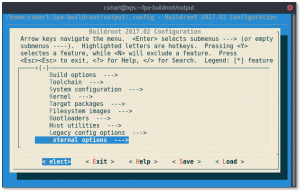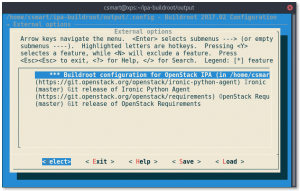Edit: See this post on how to automate the builds using buildimage scripts.
Ironic is an OpenStack project which provisions bare metal machines (as opposed to virtual).
A tool called Ironic Python Agent (IPA) is used to control and provision these physical nodes, performing tasks such as wiping the machine and writing an image to disk. This is done by booting a custom Linux kernel and initramfs image which runs IPA and connects back to the Ironic Conductor.
The Ironic project supports a couple of different image builders, including CoreOS, TinyCore and others via Disk Image Builder.
These have their limitations, however, for example they require root privileges to be built and, with the exception of TinyCore, are all hundreds of megabytes in size. One of the downsides of TinyCore is limited hardware support and although it’s not used in production, it is used in the OpenStack gating tests (where it’s booted in virtual machines with ~300MB RAM).
Large deployment images means a longer delay in the provisioning of nodes and so I set out to create a small, customisable image that solves the problems of the other existing images.
Buildroot
I chose to use Buildroot, a well regarded, simple to use tool for building embedded Linux images.
So far it has been quite successful as a proof of concept.
- Linux kernel is ~2MB
- Compressed initramfs image is ~25MB
- Passing the OpenStack Ironic gating tests
- Highly customisable (thanks to Buildroot)
Customisation can be done via the menuconfig system, similar to the Linux kernel.

Source code
All of the source code for building the image is up on my GitHub account in the ipa-buildroot repository. I have also written up documentation which should walk you through the whole build and customisation process.
The ipa-buildroot repository contains the IPA specific Buildroot configurations and tracks upstream Buildroot in a Git submodule. By using upstream Buildroot and our external repository, the IPA Buildroot configuration comes up as an option for regular Buildroot build.

Buildroot will compile the kernel and initramfs, then post build scripts clone the Ironic Python Agent repository and creates Python wheels for the target.
This is so that it is highly flexible, based on the version of Ironic Python Agent you want to use (you can specify the location and branch of the ironic-python-agent and requirements repositories).

I created the kernel config from scratch (using tinyconfig) and deliberately tried to balance size and functionality. It should boot on most Intel based machines (BIOS and UEFI), however hardware support like hard disk and ethernet controllers is deliberately limited. The goal was to start small and add more support as needed.
By using Buildroot, customising the Linux kernel is pretty easy! You can just run this to configure the kernel and rebuild your image:
make linux-menuconfig && make
If this interests you, please check it out! Any suggestions are welcome.
